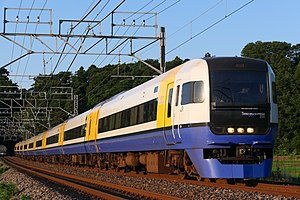Shiosai
 A 255 series EMU on aShiosaiservice in June 2021 | |
| Overview | |
|---|---|
| Service type | Limited express |
| Locale | Sōbu Main Line |
| First service | 10 March 1975 |
| Current operator(s) | JR East |
| Former operator(s) | JNR |
| Route | |
| Termini | Tokyo Chōshi |
| Distance travelled | 120.5 km (74.9 mi) |
| On-board services | |
| Catering facilities | Trolley service |
| Technical | |
| Rolling stock | 255 series,E257-500 seriesEMUs |
| Track gauge | 1,067 mm(3 ft 6 in) |
| Electrification | 1,500 V DC overhead |
| Operating speed | 130 km/h (80 mph) |
TheShiosai(しおさい)is alimited expresstrain service inJapanoperated byEast Japan Railway Company(JR East). It runs fromTokyoandShinjukutoChōshion theBōsō PeninsulainChiba Prefecture.
Station stops[edit]
Shiosaiservices operate over theSōbu Main Line,stopping at the stations listed below. All 7 round trips are operated daily except for one inbound trip which is not operated on Saturdays and holidays. No services operate as "Local" all-stations services in any section; this characteristic is different from that of Wakashio ltd.exp.[1][2][3]
Tokyo-Kinshichō-Chiba-Sakura-Yachimata-Narutō-Yokoshiba-Yōkaichiba-Asahi-Iioka-Chōshi
- No. 2, 4 & 13 trains also stop atYotsukaidōstation.
Rolling stock[edit]

- 255 series9-car EMUs (since 10 December 2005, until 15 March 2024[4])
- E257-500 series5+5-car EMUs
Shiosaiservices are operated using Makuhari-based 9-car255 seriesEMUand 10-carE257-500 seriesEMU formations. The E257-500 series formations have no Green (first class) cars.[5][2]
Future rolling stock[edit]
E259 series6-car EMUs (from 16 March 2024[4])
Past rolling stock[edit]
- 183 seriesEMUs (10 March 1975 – 2005)
Formations[edit]
Trains are formed as shown below, with car 1 at the Tokyo end.[2]
9-car 255 series[edit]
| Car No. | 1 | 2 | 3 | 4 | 5 | 6 | 7 | 8 | 9 |
|---|---|---|---|---|---|---|---|---|---|
| Numbering | KuHa 254 | MoHa 254 | MoHa 255 | SaRo 255 | SaHa 254 | SaHa 255 | MoHa 254 | MoHa 255 | KuHa 255 |
| Accommodation | Reserved | Reserved | Reserved | Green | Reserved | Non-reserved | Non-reserved | Non-reserved | Non-reserved |
5+5-car E257 series (No. 4 only)[edit]
| Car No. | 1 | 2 | 3 | 4 | 5 | 6 | 7 | 8 | 9 | 10 | |
|---|---|---|---|---|---|---|---|---|---|---|---|
| Numbering | KuHa E256-500 | MoHa E257-1500 | MoHa E256-500 | MoHa E257-500 | KuHa E257-500 | KuHa E256-500 | MoHa E257-1500 | MoHa E256-500 | MoHa E257-500 | KuHa E257-500 | |
| Accommodation | Non-reserved | Non-reserved | Non-reserved | Reserved | Reserved | Reserved | Reserved | Reserved | Non-reserved | Non-reserved |
Past formations[edit]

Trains were originally formed of 9-car183 seriesEMUs, including one Green car, or 6-car sets with no Green car,[6]but from December 1994, services were formed of 8-car 183 series sets with the Green car removed, as shown below.[7][8]
8-car 183 series[edit]
| Car No. | 1 | 2 | 3 | 4 | 5 | 6 | 7 | 8 |
|---|---|---|---|---|---|---|---|---|
| Accommodation | Reserved | Reserved | Non-reserved | Non-reserved | Non-reserved | Non-reserved | Non-reserved | Non-reserved |
History[edit]

TheShiosaiservice was introduced from 10 March 1975 following the completion of electrification of theSōbu Main Linein October 1974, using 9-car183 seriesEMUs, replacing five of the seven daily diesel-poweredInubō(Khuyển phệ)express services that operated betweenShinjuku/RyōgokuandChōshi.[8]
From the start of the November 1982 timetable revision, further 183 series EMUs were drafted in, displaced fromTokilimited express services following the opening of theJoetsu Shinkansen,[9]and the remainingInubōexpress services were discontinued and absorbed into theShiosaiservices, giving seven return workings daily.[8]
From the start of the revised timetable on 10 December 2005,255 series9-car EMUs were introduced onShiosaiservices.[10]From the same date, services were made entirely no-smoking.[10]
From the start of the 14 March 2015 timetable revision, allShiosaiservices started and terminated at Tokyo Station, with no services operating from Shinjuku.[11]
From the start of the 16 March 2024 timetable revision,E259 series6-car EMUs used onNarita Expressservices are scheduled to also be used on Shiosai services for six return trips. Meanwhile,E257 seriestrains in 5-car formations will continue to be used for one return trip. As a result, 255 series sets will no longer operate on these services.[4]
See also[edit]
References[edit]
- ^JR Timetable.Japan: Kotsu Shimbunsha. April 2016. pp. 95–95, 984.
- ^abcThiên diệp を tẩu る liệt xa >しおさい: EAST JAPAN RAILWAY COMPANY Chiba branch Japan
- ^Thiên diệp を tẩu る liệt xa >わかしお: EAST JAPAN RAILWAY COMPANY Chiba branch Japan
- ^abc"2023【ダイヤ cải chính nhật 】 2024 niên 3 nguyệt 16 nhật ( thổ ) - JR đông nhật bổn"[2023[Timetable revision date] Saturday, March 16, 2024 - JR East](PDF)(in Japanese). JR East. 15 December 2023.Retrieved22 December2023.
- ^JR tân càn tuyến & đặc cấp liệt xa ファイル[JR Shinkansen & Limited Express Train File]. Japan: Kotsu Shimbun. 2008. p. 646.ISBN978-4-330-00608-6.
- ^Quốc thiết điện xa biên thành biểu 1985 niên bản[JNR EMU Formations - 1985]. Japan: Kotsu Shimbunsha. October 2010. p. 30.ISBN978-4-330-17610-9.
- ^こだわりの tân càn tuyến & đặc cấp liệt xa ガイド[In-depth Shinkansen & Limited Express Guide]. Japan: Ikaros Publishing. August 2000. pp. 84–85.ISBN4-87149-284-2.
- ^abcTeramoto, Mitsuteru (July 2001).Quốc thiết ・JR liệt xa danh đại từ điển[JNR & JR Train Name Encyclopedia]. Tokyo, Japan: Chuoshoin Publishing Co., Ltd. p. 266.ISBN4-88732-093-0.
- ^JR đặc cấp liệt xa niên giam 2013[Limited Express Annual 2013]. Tokyo, Japan: Ikaros Publications Ltd. 20 December 2012. p. 166.ISBN978-4-86320-654-0.
- ^abJR điện xa biên thành biểu 2012 đông[JR EMU Formations - Winter 2012]. Japan: Kotsu Shimbunsha. October 2011. pp. 50–51.ISBN978-4-330-25611-5.
- ^JR Timetable.Japan: Kotsu Shimbunsha. February 2015.EAN4910053110259.
External links[edit]
- JR East 255 series Shiosai/Wakashio/Sazanami(in Japanese)
- JR East E257 series Wakashio/Sazanami/Shiosai/Ayame(in Japanese)
